

Missile
Fire & The Archer Subclass
by
Leomund (Len Lakofka)
Fighters,
all humanoids and, to some degree, Thieves are underrated
when it comes to their abilities to project
missiles. Many melees
are conducted with no missile fire whatsoever
because the rules for
missile fire are perhaps a bit hard to
handle. DMs too often forget that
missiles should be used by both sides
in melee. Missiles not only kill
opponents, they often prevent the use
of a spell if they can hit and
damage the target spell-caster before
he/she/it can finish casting the
spell.
Here is a method of determining whether
a spell is ruined:
Consider all blows in melee to be landing
in the middle of a segment.
Likewise, consider all missiles to be
hitting in the middle of a segment.
Consider all casting times as beginning
in the first moment of a
segment and ending in the final moment
of the last segment, as
called for by the spell’s casting time.
If a blow hits for damage in any
segment of a spell’s casting time, the
spell is ruined. Thus if a goblin,
for example, strikes with simultaneous
initiative at a Magic-User
casting Magic
Missile, the Magic-User’s spell is ruined if the goblin
hits.
Missiles, once launched, will consume time
while in flight. However,
it is wasted effort to try to precisely
figure every missile’s flight
time. I’d suggest the creation of some
simple “in flight” guidelines:
Any missile fired or cast will have the
same flying speed. Those fired
less than 50 feet from the target will
reach the target in the middle of
the first segment after being fired. Those
traveling to a target
between 51 and 200 feet away will be in
flight for an additional
segment. For targets 201 to 400 feet distant,
add one more segment,
401 to 600 feet, one more, etc. Obviously,
you may determine your
own parameters for flight time, but I
feel these work best in the game
system now being used, because the flight
times have been calculated
to be compatible with casting times, movement
speeds, etc.
A missile is considered to be fired at
the end of a segment. Thus, if
an archer firing on a Magic-User gets
an initiative of 1, the arrow will
take flight at the very end of segment
number one. It will hit its target
(if within 50 feet) in the middle segment
number two. If the archer
had a Sleep spell cast at him simultaneously
by the M-U, the arrow
would still be in flight. If the Sleep-casting
Magic-User got an initiative
of 2 and was within 50 feet of the archer,
then the spell would be
ruined if the arrow hit.
A blow in melee would ruin an intention
to fire a missile, since
blows hit in the middle of a segment.
Thus, in the example mentioned,
if a Thief struck the archer from behind
in segment number
one and hit for damage, the archer would
not be able to fire.
This system will make conducting all missile
fire far more easy.
Note that over long distances both targets
might be hit if missiles are
exchanged or if a missile is fired at
a spell caster, even if the actions
are not taken simultaneously. Once a missile
is airborne most spells
cannot affect it if they are cast at the
archer/thrower.
"Segment of Action" update
Earlier in the Leomund’s Tiny Hut series
(Dragon #34), the
“Segment
of Action” system of rules for melee were discussed. Here
is an update of those rules as they apply
to melee and missile fire.
First, and most important, a six-sided
die should be used for “initiative”
and not the ten-sided die earlier suggested
(in #34). The
reason for the change is that waiting
until the 7th, 8th, 9th or 10th
segment for the first blow gives too much
advantage to spell-casters
who use only a four-sided die in most
cases for determining their
spell-casting initiative. The six-sided
die tells if the action of launching
a missile will occur in the 1st, 2nd,
3rd, 4th, 5th or 6th segment
and is not meant to imply that the round
is divided into six segments
instead of ten. Missile fire also uses
the six-sided die plus a second
six-sided die for the second arrow, if
applicable (some types of
arrows allow for a rate of fire of two
per round). If the two dice add up
to 11 or 12, then no second arrow firing
is allowed that round.
However, the archer could quite correctly
launch that arrow at the
end of the 1st or 2nd segment of the next
round, assuming he/she/it
has not been struck, enspelled, etc.
The “Segment of Action” system must sometimes
be overruled
by common sense. If, for example, a Magic-User
decides to cast
Polymorph Other on a goblin standing right
in front of him hoping
that his initiative will be 1 and his
opponent’s 5 or worse, the DM
should have the goblin react by ignoring
its initiative roll and striking
almost immediately. It is one thing for
a spell caster to attempt a oneor
two-segment spell. He or she might just
get away with it. But spells
taking three or more segments to cast
will render the spell-caster
almost immobile for too long a time. No
opponent will just bob and
weave waiting for his segment-of-action
versus a basically immobile
opponent. The solution is a re-roll the
initiative using the Magic-
User’s first segment of spell-casting
as the base. If the opponent
already has an early segment-of-action
this may not be necessary.
Use d4 for this initiative. Example: The
spell-caster tries to cast a
4-segment spell. His initiative is 2.
Roll d4 for his opponent and
apply the result based on the fact that
the spell-caster began to cast in
segment #2. Even if 4 is rolled the attempted
blow will take place in
the middle of segment number 5, not number
6 (when the spell
would take effect). A roll of 1 equates
to the strike occurring in the
middle of segment #2, a 2 to the middle
of segment #3, a 3 to the
middle of segment #4 and a 4 to the middle
of segment #5. Since
the spell-caster’s spell does not go off
until after the end of segment
#5, any blow that hits for damage will
negate the spell.
A really intelligent monster will not
try for a weapon/claw/bite
attack in such a situation. He/she/it
will try to overbear/pummel/
grappel or use some rapidly employed weapon
like breath or glance
(if the monster has this ability). How
can that action be judged? Take
the “monster’s” Intelligence and multiply
by 5%. Add that to a base
of 35%. This means any monster of Intelligence
13 or higher will
always know that overbearing/pummeling/grappeling
is the thing to
do in such a situation unless he/she/it
possesses some even more
rapid attack/device. Such physical attack
will almost always destroy
the spell the spell-caster is attempting,
and rightly so.
Target size and
range adjustments
Those who are familiar with the Errol
Flynn movie Robin Hood may
recall a scene when he kills four or five
men-at-arms
with single arrow shots, all within one
minute (I've timed some
of the missile-firing melee scenes). We
have all seen some movies
in which the bow (usu. the longbow) is
fantastically accurate
and deadly. This pre-conditioning, if
you will, confuses many a
new player of the D&D or AD&D
game. The novice might
give up if the leader of a group of orcs
shouts out to his troops,
"Stand and deliver!" because the player
has a fear of the bow. On
the other hand, the party might refrain
from missile fire for the
opposite reason: Most monsters met in
an encounter cannot be killed
by a single arrow. Are, or were, archers
really as good as
they are sometimes portrayed to be?
In fact, an English longbowman could hit
and kill a figure at 400
yards! This was, however, the rare shot
and not the rule. The number
is also based upon fire into a group of
figures and rarely, if ever, was
achieved by a single shot at a lone target.
The maximum D&D/
AD&D longbow range is 21 inches
which equates to 630 feet outdoors,
a mere 210 yards. How can this range inequity
be taken care
of? Well, it cannot without unbalancing
the game. Remember that
movement and spell range, to say nothing
of casting time, is tied to
selecting distances. If bow range is tampered
with it will throw off the
other numbers. However, in the Archer
and Archer-Ranger subclass
(hereafter) some increase in range is
allowed for strong characters.
On page 64 of the DMG we find armor class
modifications for the amount of cover
a target is concealed behind.
The target is assumed to be a human-sized
figure; at least, that is
what it seems to mean. What happens if
the target is larger/smaller/
moving/flying? The “target cover” adjustments
give us a basis for
making armor class adjustments based on
target size and range.
It must be clearly understood that the
given adjustments to armor
class involve the size of the target and
not the armor actually worn.
The basic subtractions of -2 “to hit”
at medium range and -5 at
long range still apply. They apply to
Archers and Archer-Rangers (as
described hereafter) as well. This basic
adjustment due to range is
taken from the armor class before the
“to hit” roll, as is the size
adjustment. A target becomes “arrow proof’
when a 21 or better is
required to hit. The armor class determination
should take into
account all adjustments for magic, strength,
skill, etc.
Example: A Kobold
is at long range from a Fighter with
a longbow.
The Kobold’s armor class
is 6. The Fighter is using a + 1 bow.
His Strength gives him +2
to hit and +5 to damage. However, his
strength is taken into account
at short and “point blank” ranges only
(full at “point blank”,
i.e. under 50 feet, and half rounded down at
short range) and only then
for trained Fighters with special bows (see
hereafter for a full explanation).
The Kobold’s armor class is adjusted
three places to the better
(see chart above) due to its small size
relative to a human target
at long range; its effective armor class
becomes 3. At long range
there is a basic -5 adjustment for range
alone, so the Kobold is
now considered armor class -2. The Fighter’s
Strength does not apply
at long range, but his bow is + 1, so the
Kobold’s armor class becomes
- 1. That would be the final armor
class used to see what the
“to hit” number is.
In the same example, if the
Kobold were at short range the
calculation of armor class
would be as follows: Base class 6, range
adjustment - 1 changing
AC to 5, Strength adjustment is +2, halved
to + 1, so AC is back to
6, and the bow is + 1 changing the AC to 7. If
the Fighter were an Archer
(see hereafter), a bonus for skill would
also apply.
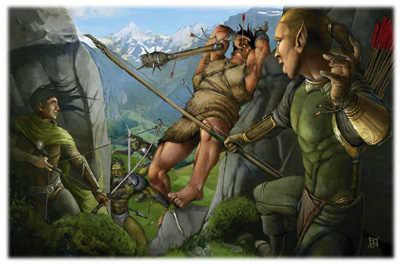
<The following chart is mathematically inaccurate: see "Target Sizes" in the article "Aiming for Realism in Archery" for the corrected figures.>
| - | - | Armor Class
Adjustment for Range |
- | - | - |
| Target Type (Size) | % of Human Size | Long | Medium | Short | Point-blank |
| "Broad side of a Barn" (21') | 525+% | +3 | +5 | +6 | +8 |
| Storm giant (21') | 375-500% | +2 | +4 | +5 | +6 |
| Cloud giant (18') | 300-350% | +2 | +3 | +4 | +5 |
| Frost giant (15') | 225-275% | +1 | +2 | +4 | +5 |
| Ettin (13') | 200% | +1 | +2 | +3 | +4 |
| Fire/Stone giant (12') | 175% | +1 | +2 | +3 | +4 |
| Ogre mage, Djinni, Hill giant (10 1/2') | 150% | 0 | +1 | +2 | +3 |
| Ogre, Troll (9') | 125% | 0 | 0 | +1 | +2 |
| Bugbear, Gnoll (7') | 110% | 0 | 0 | 0 | +1 |
| Troglodyte, Hobgoblin (6 1/2') | 105% | 0 | 0 | 0 | 0 |
| Man, Orc (6') | 100% | 0 | 0 | 0 | 0 |
| Elves (5') | 90% | -1 | 0 | 0 | 0 |
| Dwarf, Goblin (4') | 75% | -2 | -1 | 0 | 0 |
| Halfling, Kobold, Gnome (3') | 50% | -3 | -2 | -1 | 0 |
| Pixie (2 1/2') | 40% | -4 | -3 | -2 | -1 |
| Imp, Sprite, Leprechaun (2') | 30% | -6 | -4 | -3 | -2 |
| Brownie, Homonculous (1 1/2') | 20% | -8 | -6 | -4 | -2 |
| Quasit (1') | 10% | -10 | -8 | -6 | -3 |
| Robin (1/2') | 5% | -17 | -13 | -9 | -5 |
| Wren (1/4') | 2% | -24 | -19 | -12 | -6 |
| Coin (1") | 1/2% | invisible | -21 | -14 | -7 |
Point Blank (under 50 feet) applies only
to trained archers.
Note: This chart does not consider color
or contrast of the target
against its background.
“Arrow proof” targets can still be hit
by fully trained Fighters as
well as Archers and Archer-Rangers. To
accomplish this the 20-
sided die must be rolled twice. The first
roll must be a “natural” 20.
At that time the second 20-sided die is
cast to see if an extraordinary
shot has occurred:
| Required to hit after all adjustments
tabulated for armor class target |
Second roll for
extraordinary hit |
| 21 | 13 or better |
| 22 | 15 or better |
| 23 | 17 or better |
| 24 | 18 or better |
| 25 | 19 or better |
| 26 | 20 |
| 27 | 20 |
| 28 or higher | impossible |
Adjusting for
motion
Mobile targets are harder to hit. Any
target moving at over “walk
speed,” i.e. 100 feet/minute, is -2 to
armor class. Further adjustment
can be made up to a -5 modification for
very fast-moving
targets. Fast targets moving in a straight
line should not receive as
great an adjustment as a target moving
rapidly and in an evasive
manner.
What if the archer is moving? The subtraction
from the target’s
armor class should be at least -2 for
slow movement on foot, up to
-7 for being astride a trotting mount.
Firing from any kind of flying
mount is possible, but only from a mount
in steady, level flight. A
maneuvering flying mount would render
archer fire from it impossible.
Strength and
hurled missiles
A bonus to hit and/or to damage due to
a character’s Strength
can be taken into account when that character
or creature hurls a
missile. Such missiles are throwing daggers,
throwing axes, spears,
hammers, and javelins (not darts). To
gain a Strength bonus the
figure must be proficient with the weapon.
However, Magic-Users
never gain a Strength bonus to hit or
to damage from a thrown
dagger (aside: Magic-Users must learn
to throw a dagger. First- to
fifth-level M-Us are -5 to hit with a
dagger, whether they like it or
not, whenever they try to throw it.).
A Thief can gain a Strength
bonus with a thrown dagger but never if
he/she is trying for a “back
stab” bonus.
The full bonus to hit and to damage is
awarded for targets within
15 feet of the thrower. For the balance
of the short-range distance,
16 to 30 feet (16 to 60 feet for a javelin)
half the bonus is awarded.
Halved bonuses are rounded down. Giants
gain their full strength
bonus to damage whenever the target is
within 20 feet. (See other
notes on Strength in Leomund’s Tiny Hut,
Dragon
#43.)
Dear Editor:
I’ve been involved in the D&D®
game for
about a year now, and it always bugged me
that there was no provision for archers in the
combat system or the character classes. So
you can imagine my enthusiasm when I saw
the Leomund’s Tiny Hut article in #45. However,
I have a few complaints about parts of
that article which I wish to air, in the order of
their appearance in the article.
1st — “Magic-Users must learn to throw a
dagger. First to fifth-level M-Us are -5 to hit
with a dagger, whether they like it or not,
whenever they try to throw it.” Not only do I
not like this, but I will not accept it. If a person
decides to become a Magic-User, he will be
aware, or informed, of his/her limitations as to
weaponry. An MU will, therefore, learn to
throw a dagger, darts, use a staff, all while
learning to be a MU. The only excuse for such
a subtraction is poor Dexterity, 11 or less for
example, and then it should be a subtraction
of one for each point below that minimum
level.
2nd — “Kobolds, goblins, dwarves,
gnomes and halflings cannot become archers.”
In the last chapter of the third book of the
Lord of the Rings trilogy, there are no less
than three incidents where the effectiveness
of hobbit archers is demonstrated. Also, refer
to the AD&D Monster Manual, p. 50, under
halflings, under special attacks,
note “+3 with
bow or sling.”
3rd — “It is very rare for an archer to use a
short bow or any type of crossbow. Archers
gain no bonuses to hit or damage from those
latter missile weapons.” According to my information,
the crossbow was invented BEFORE
the longbow! It was a portable arbalest
(a siege weapon used to hurl stones or spears
over castle walls). The Chinese invented a
5-shot repeating version of the crossbow, to
the detriment of the Huns. A crossbow is as
accurate as a rifle at distances of up to 500
yards, and more effective than a rifle at that
distance, due to the blades on the head (of the
bolt). Crossbows were used to smash through
the armor used at the time. Only the thickest
of shields could deflect a bolt, and no body
armor could stop a direct hit.
An archer could be trained to use a crossbow
in far less time than a longbow, but once
(one was) learned it was all but impossible to
learn the other. An archer should specify
which bow he is using, and receive a subtraction
on his “to hit” number if he tries to use the
other. If the crossbow is specified, state what
kind it is. Some could be cocked by hand;
these will have a range equal to that of the
best longbow, a touch more accuracy, and
half the rate of fire as for a crossbow that
cannot be cocked by hand. Others were
cocked by a windlass (a rope-and-pulley arrangement).
These can reach out to 500 yards
with good accuracy, but you’ll only get one
shot off every three rounds. At close range,
such a weapon is useless.
As for the statement made about the short
bow, refer to my statement concerning hobbits
(what else would they use?).
The balance of the article was interesting
and informative. I have already earmarked
one of my future characters as an archer.
(Please note that all of my rebuttal refers to
normal weapons used by persons with normal
strength. Obviously an archer with 18/00
Strength could get off one shot per round
even with the most powerful of crossbows,
because he could cock it by hand.)
William G. Welsh
Detroit, Mich.
(Dragon #49)
This is by no means the first letter of this
general type that we have received, and it
surely won’t be the last. Generally, our response
to William’s arguments is the same as
on other previous occasions when we’ve dealt
with a “Here’s what’s wrong with this article”
letter: First and foremost, we do NOT deal
with the “facts” of the situation — for instance,
whether or not William’s descriptions
of the crossbow are factual and historically
accurate. This is not the place to stage a confrontation
over crossbows, because the “rightness”
or “wrongness” of information like this
is secondary to the main issue, which is this:
None of the ideas presented in articles in
DRAGON magazine are official rule
changes
or additions, unless the article specifically
says so (and there haven’t been very many of
those). The people who write articles that we
publish aren’t trying to get everyone to play
the way they do, and we certainly don’t hold
that opinion ourselves. As is the case with
many of the game rules themselves, the articles
in DRAGON magazine are suggestions,
ideas and alternatives. Any DM or player who
can make use of part of the information in an
article but wants to delete or alter other things
in the same article is entirely free to do so.
Whether a particular rule or an entire campaign
is “authentic,” playable, or even desirable
is a decision that can only be made by the
members of the playing group or the DM, not
by what we decide to publish in the pages of
DRAGON magazine.
In the case of a Leomund’s
Tiny Hut article,
the above statements apply to a greater degree
than for other types of articles. The ideas
expressed in Len Lakofka’s column are entirely
his own, and are almost all, if not all, based
on the campaigns which he has conducted
over the past several years. The way Len Lakofka
does something is not necessarily the
way William Welsh, or anyone else, has to do
it. Len takes special pains to point this out in
the text of his columns, emphasizing in one
form or another the fact that his columns are
unofficial, and any reader, player or DM is free
to alter or eliminate any sections of an article
which do not suit him or her.
One minor point that has been made before
but bears repeating has to do with William’s
second objection. Regardless of how anyone
feels about whether halflings can be archers
or not, it is a fact that no direct connection is
intended or should be inferred between the
halfling character as depicted in the D&D
and
AD&D rules and the hobbit character
as portrayed
in Tolkien’s books. It is no
secret that
the halfling race is, at least in superficial ways,
modeled rather closely after the hobbit. But
this alone is not enough to draw a firm parallel
between the two character types. The rules
for the D&D and AD&D game systems drew
some of their inspiration from the Ring trilogy,
as well as from dozens of other works of
fantasy and historical literature. Again, any
particular DM or group of players can choose
to develop a campaign which is as faithful to
Tolkien’s world as they can make it. However,
it is inappropriate to demand or suggest that
the rules for AD&D be “bent” to accommodate
this world view. Any group which plays
AD&D strictly by the books will not be able to
stage a Tolkien-type campaign. Any group
which chooses to change some of the official
rules is free to do so, as long as the changes
are agreeable to those in the group. But
changed rules aren’t rules, and Middle Earth
is not a D&D universe.
— KM
(Dragon #49)
Leomund takes aim
Dear Editor:
I would like to reply to Mr. Welsh’s letter in
DRAGON #49 (concerning Leomund’s Tiny
Hut in issue #45, which described the archer
as a non-player character — Ed.)
First, an AD&D magic-user is not
a fighting
class. He or she resorts to a dagger, dart or
quarter staff as a last resort. His or her main
interest (read, only interest) is magic. He or
she can only learn one weapon initially and
one new weapon at levels 6, 11, etc., as per the
Players Handbook. AD&D
magic-users wield
weapons at a -5 non-proficiency rating, also
as proscribed in the PH. Therefore they are
not knife throwers, nor do they want to be.
Players might like their m-u’s to be a knife-throwing
guy with a bandolier of six daggers
hanging over each shoulder and a belt holding
a half-dozen darts on each hip. Alas, their
fate is to cast magic and use magic items, not
to sling darts and daggers.
Second, this is not The Lord of The Rings.
Further, the archer subclass is one that uses
long bows and not short bows. Therefore,
there is no bonus for halflings.
Third, I do not much care when the crossbow
was invented, nor how far it can fire. The
ranges in AD&D are set by Mr. Gygax, and if
you wish to change them you must also
tamper with other ranges, spell casting times,
etc. I do not find that task worthwhile, since it
produces a variant of AD&D which is unique
to your campaign. Such radical variance will
give your players a false sense of security in
other campaigns or tournaments where strict
AD&D rules are used.
Finally, I have a romantic love for long
bows. Anyone who has seen Errol Flynn’s
Robin Hood will hate the cursed crossbow
and
favor the wonderful long bow. Pooh on crossbows,
pooh!
Lenard Lakofka
Chicago, III.
(Dragon #51)
A
new non-player character class:
Archers and Archer-Rangers
The principal attributes of an Archer
are strength and dexterity,
both of which must be 15 or better. Intelligence,
Wisdom and
Charisma must be at least 6 and Constitution
at least 9. Archer-
Rangers require an even higher Intelligence,
Wisdom and Constitution,
a minimum of 14 in each. Archers and Archer-Rangers
whose
Strength and Dexterity are both 16 or
better gain 10% to earned
experience.
While Archers may be of any alignment,
Archer-Rangers must be
Good.
Archers can be human, elf, half-elf, or
half-orc, as well as some
other humanoid races. Humanoids are limited
in level as an Archer
as follows: Orcs can become 3rd-level
Archers, Gnolls can become
5th-level Archers, Hobgoblins can become
4th-level Archers.
Kobolds, Goblins, Dwarves, Gnomes and
Halflings cannot become
archers.
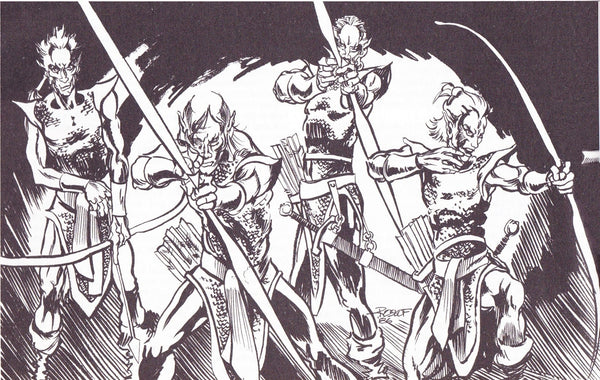
Archer-Rangers can be human or half-elf.
Demi-humans and
non-humans not mentioned above are limited
to becoming 8th-level
Archers or Archer-Rangers.
Archers and Archer-Rangers use an 8-sided
die for HP
determination. At first level, two 8-sided
dice are thrown, just as the
Ranger class does. All Archers add 2 hit
points per level after the 9th
level.
Archer or Archer-Ranger Table
340,000 XP per level for each additional level beyond the 14th.
Archers and archer-rangers gain 2 HP per level after the 9th.
All Archers may use a wide selection of
armor, but the use of
plate armor will negate an Archer’s “to
hit” bonuses and thus he/she
will surely decline to use this type of
armor. A shield can be carried,
but obviously it must be set aside when
arrows are fired. Archers
have a great selection of weapons available,
but this selection is not
as broad as that of a Fighter. They may
use, in addition to their
long/composite/great bow, the following
weapons: swords of any
type, dagger, axes of any type, a spear
or javelin, darts, or scimitars.
Archers rarely use blunt weapons like
a mace, hammer or flail.
Archers do not use pole arms except for
the throwing spear. It is very
rare for an archer to use a short bow
or any type of crossbow.
Archers gain no bonuses to hit or damage
from those latter missile
weapons.
Archers and Archer-Rangers have the same
saving throws as
Fighters. They melee on the Fighter table.
All Archers begin with
only two weapons, a bow and almost always
some type of sword.
Thereafter they may add one weapon every
3rd level, just as other
fighting classes do. However, their non-proficiency
penalty is -3. All
Archers can make only one hand-to-hand
melee attack per round
through the 8th level. At the 9th level
through 15th levels, they can
strike three times in two rounds. They
gain two attacks per round
only at 16th level and higher. At 7th
level and above all Archers can
fire three arrows per round instead of
just two. All Archers can
employ those magical items usable by all
classes plus many other
items as well. A magic bow and/or a magic
arrow operates at + 1 in
an Archer’s hands, over and above any
magical bonus to hit and/or
damage it may already have.
However, elven Archers do not gain this
+ 1 to hit with a longbow because of their smaller-than-human size.
At 9th level, an Archer can establish a
“freehold” just as a Fighter,
can (see Players Handbook, page 22). However,
Archer-Rangers
cannot build such a freehold (Players
Handbook, page 25).
The following applies only to Archer-Rangers.
In melee, Archer-
Rangers gain + 1 to damage vs. the “giant
class” just as Rangers do.
Archer-Rangers are as stealthy as a Ranger.
Archer-Rangers track
like a Ranger does. Archer-Rangers attract
a body of 2-24 followers
just as a Ranger does. However, Archer-Rangers
only gain Druidic
spells, save for some very specific Magic-User
spells outlined hereafter
for both Archer-Rangers and Archers. Druidic
spells are gained
at the 8th level and follow the chart
given for Rangers. Archer-
Rangers do not gain any special advantage
from non-written magic
items pertaining to clairaudience, clairvoyance,
ESP, and telepathy,
such as a Ranger can.
All Archers can learn some specific Magic-User
spells, but to do
this Intelligence must be 9 or higher.
When the spell is to be taught by
a Magic-User, the Archer must check to
see if he/she can learn it, as if
he/she were a M-U. Failure forever negates
that particular spell.
Archers cannot read spells from scrolls
in any case, and neither can
they pen their own spells.
Archers may use particular spells beginning
at the 7th level of
ability. The number of spells usable and
the list from which the
Archer may choose changes as the Archer’s
level increases:
| Level of Archer | # of Spells Usable | Which Spells Possible |
| 7th-8th | 1 | Magic Missile, Shield |
| 9th-10th | 2 | Strength, Mirror Image plus above |
| 11th-12th | 3 | Flame Arrow, Protection from Normal Missiles plus above |
| 13th and up | 4 | Enchanted Weapon (bows & arrows only) plus above |
At 3rd level any archer can make arrows
for his/her bow, assuming
the proper raw material is obtained. He/she
can craft a dozen
arrows in an 8-hour day. At 5th level
any archer can make a long/
composite/great bow. This process takes
9-14 days and also assumes
proper materials are at hand. A crude
bow that is -2 to hit and
from which the Archer gains no bonuses
whatsoever can be crafted
by an Archer in less than an hour.
An Archer’s major attribute is an enhanced
ability to hit and
damage a target with bow and arrow. This
bonus applies only if an
archer is not wearing plate armor, as
previously noted. He/she must
be using a well made bow and well crafted
arrows. The bonus applies
to any target of human size, and may be
further modified upward or
downward depending on the target size
and relative motion of
archer and target (see preceding discussion).
The bonuses to hit and
to damage must be awarded at each level
promotion of the archer.
Remember also that a + 1 Bow is +2 in
the hands of an archer, over
and above any bonus given here! The same
“extra +1” is true of
arrows.
Archers use the range of “point blank”
in addition to the short/
medium/long ranges for most missiles.
For an archer, point-blank
range is from 10 to 50 feet. Other ranges
remain the same. (Hereafter
are given range changes for exceptionally
strong characters,
which may be used for Archers at the DM’s
option.
Note: The bonuses to hit/damage given
below do not include
the -2 and -5 adjustments to armor class
which must always be
applied at medium and long range, respectively.
Bonus to hit/damage at the range given:
| - | Point-blank | - | Short | - | Medium | - | Long | - |
| Archer level | Hit | Dam. | Hit | Dam. | Hit | Dam. | Hit | Dam. |
| 1 | +1 | - | - | - | - | - | - | - |
| 2 | +1 | +1 | +1 | - | - | - | - | - |
| 3 | +2 | +1 | +1 | +1 | - | - | - | - |
| 4 | +2 | +2 | +1 | +1 | +1 | - | - | - |
| 5 | +3 | +2 | +2 | +1 | +1 | +1 | - | - |
| 6 | +3 | +3 | +2 | +2 | +1 | +1 | +1 | - |
| 7 | +4 | +3 | +3 | +2 | +2 | +1 | +1 | - |
| 8 | +4 | +4 | +3 | +3 | +2 | +2 | +1 | +1 |
| 9 | +5 | +4 | +4 | +3 | +3 | +2 | +2 | +1 |
| 10 | +5 | +5 | +4 | +4 | +3 | +3 | +2 | +2 |
| 11 | +6 | +5 | +5 | +4 | +4 | +3 | +2 | +2 |
| 12 | +6 | +6 | +5 | +5 | +4 | +4 | +3 | +2 |
| 13 | +7 | +6 | +6 | +5 | +5 | +4 | +3 | +2 |
| 14 | +7 | +7 | +6 | +6 | +5 | +5 | +3 | +3 |
No matter how well an Archer is capable
of shooting, a roll of 1
on the “to hit” die is always a miss.
(Normal missile-firing troops
always miss on a 1 or 2.) As an example
of how to use the above chart,
a 7th-level Archer with a +1 bow firing
a +2 arrow at point-blank
range would have this bonus to hit and
damage: + 1 for the bow and
+ 1 more because an archer is firing it;
+2 for the arrow and + 1 more
because an archer is firing it; +4 to
hit due to skill and +3 to damage
due to skill at point-blank range for
an overall bonus of +9 to hit and
+8 to damage!
All archers, and optionally any trained
figure with a long/composite/
great bow, can also do extra damage and
gain greater accuracy
through use of physical strength. This
can only be accomplished
via the use of specially made bows and
arrows with a greater “pull.”
Normal bows and arrows cannot be used,
nor can any short bows or
any type of crossbow. Such a bow must
be crafted by an Archer, an
Archer-Ranger, or an elf bowmaker who
is at least 6th level as an
Archer, Archer-Ranger or Fighter. Proper
“long arrows” must be
crafted by an Archer, an Archer-Ranger
or an elf fletcher of at least
4th level. Ordinary fletchers can only
make normal arrows.
Strength applies to point-blank range
and short range only! Full
strength bonuses as given in the Players
Handbook will apply; +3 to
hit and +6 to damage is the maximum bonus
allowed due to
Strength. Girdles of Strength will NOT
provide a further bonus for
this purpose. At short range the bonus
to hit and damage due to
strength is halved (fractions are dropped).
This bonus for Strength is
in addition to an Archer’s bonus for great
skill.
Strength
of an Archer or Archer-Ranger may also allow for an
expansion of the long-range end of a bow’s
potential. Only specially
made bows will give greater range. Only
the top end of the longrange
category is expanded; Medium-range distance
stays as given
in the Player’s Handbook. Given
below are ranges for each type of
bow allowed to an Archer, Archer-Ranger
or strong Fighter, according
to the Strength of the character. Remember,
the bow and arrows
must be special.
| Strength | Point-
blank |
Short | Medium | Long
comp. |
Long
bow |
Great
bow |
| 9-15 | 10-50 | 51-210 | 211-420 | 421-630 | 421-630 | 421-630 |
| 16 | - | - | - | 421-630 | 421-640 | 421-630 |
| 17 | - | - | - | 421-640 | 421-650 | 421-640 |
| 18 | - | - | - | 421-640 | 421-660 | 421-650 |
| 18/01-50 | - | - | - | 421-650 | 421-670 | 421-660 |
| 18/51-75 | - | - | - | 421-650 | 421-680 | 421-660 |
| 18/76-90 | - | - | - | 421-660 | 421-690 | 421-660 |
| 18/91-99 | - | - | - | 421-660 | 421-700 | 421-660 |
| 18/00 | - | - | - | 421-670 | 421-720 | 421-660 |
Only Archers and Archer-Rangers who reach
8th level or above
can craft arrows that can be magicked
to become Arrows of Slaying.
The magic must be accomplished by a Magic-User
with the following
spells: Enchant an Item, Wish and Trap
the Soul. Fresh blood from
the figure type to be slain must be available.
Thus, it is virtually
impossible to craft an arrow for use versus
a unique character like
Bahamut, Tiamat, any Deity, etc.
It is not uncommon for Archer-Rangers to
have a double title,
like Fletcher-Scout or Ranger-Archer.
Note that the Ranger-class
title is given first. Any individual might
only state part of his/her title.
Note that the experience points necessary
for each level are the same
for Archer or for Archer-Ranger.
(By the way, Errol
Flynn’s Robin Hood was an Archer Grandmaster
and not a Thief of any type. Consider
Flynn’s statistics as
follows: S 16, I 17, W 15, O 18, C 18,
Ch 17, 14th-level Archer
Grandmaster, Leather +2 for AC: 6/2, HP:
110, Long Sword +2,
Long Bow +3.)
1. SUBCLASS = n/a
2. SOCIAL CLASS MINIMUM =
3. ABILITY SCORE MINIMUMS
STRENGTH =
INTELLIGENCE =
WISDOM =
DEXTERITY =
CONSTITUTION =
CHARISMA =
COMELINESS =
4. POSSIBLE RACES & MAX. LEVEL ATTAINABLE
=
5. MULTI-CLASS POSSIBILITIES =
6. HIT DIE TYPE =
7. MAXIMUM NUMBER OF HIT DICE =
8. SPELL ABILITY =
9. ARMOR PERMITTED =
10. SHIELD PERMITTED =
11. WEAPONS PERMITTED = They may use,
in addition to their
long/composite/great bow, the following
weapons: swords of any
type, dagger, axes of any type, a spear
or javelin, darts, or scimitars.
Archers rarely use blunt weapons like
a mace, hammer or flail.
Archers do not use pole arms except for
the throwing spear. It is very
rare for an archer to use a short bow
or any type of crossbow.
12. OIL PERMITTED =
13. POISON PERMITTED =
14. ALIGNMENT =
15. STARTING MONEY =
16. WEAPON PROFICIENCIES =
17. NON-PROFICIENCY PENALTY =
18. NON-WEAPON PROFICIENCIES =
19. STARTING AGE =
20. COMBAT =
21. SAVING THROWS =
22. MAGIC ITEMS =
rg-
zb.
NAMES
Belfram (human archer-ranger) (Thanks: Norman K Kelly, RIP Todd)
37.
36.
35.
34.
An arcane archer.
33.
32.
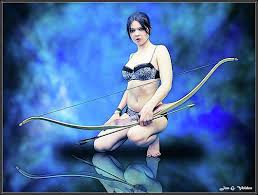
31.
30.

29.
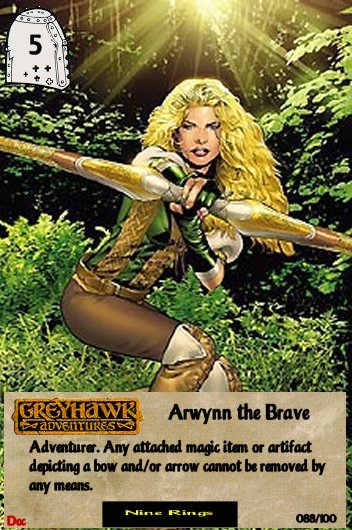
28.
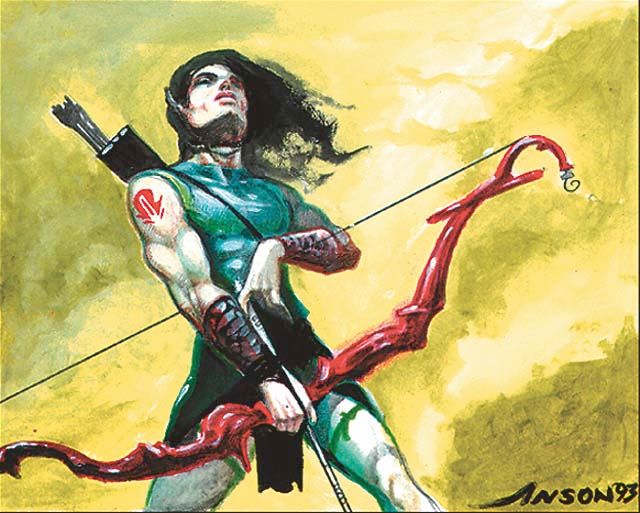
27.
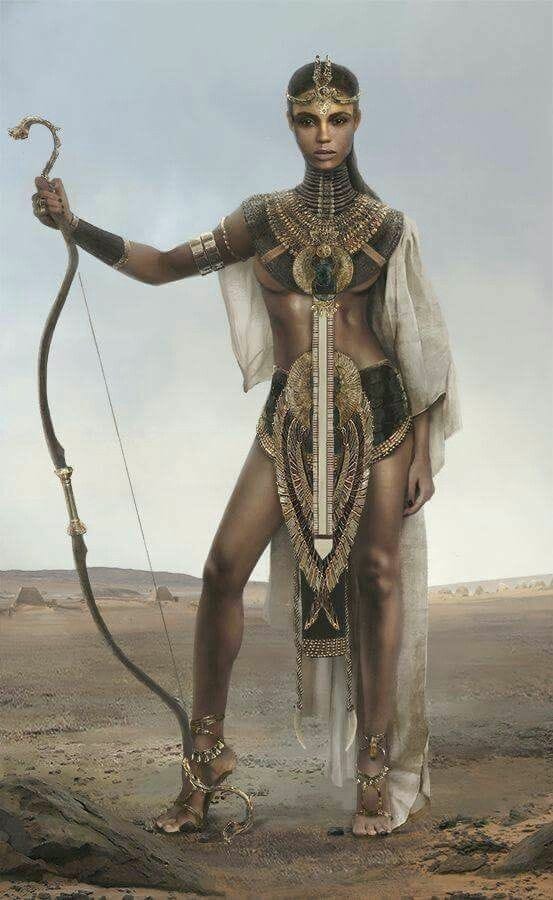
26.
25.

24.
23.
22.
21.
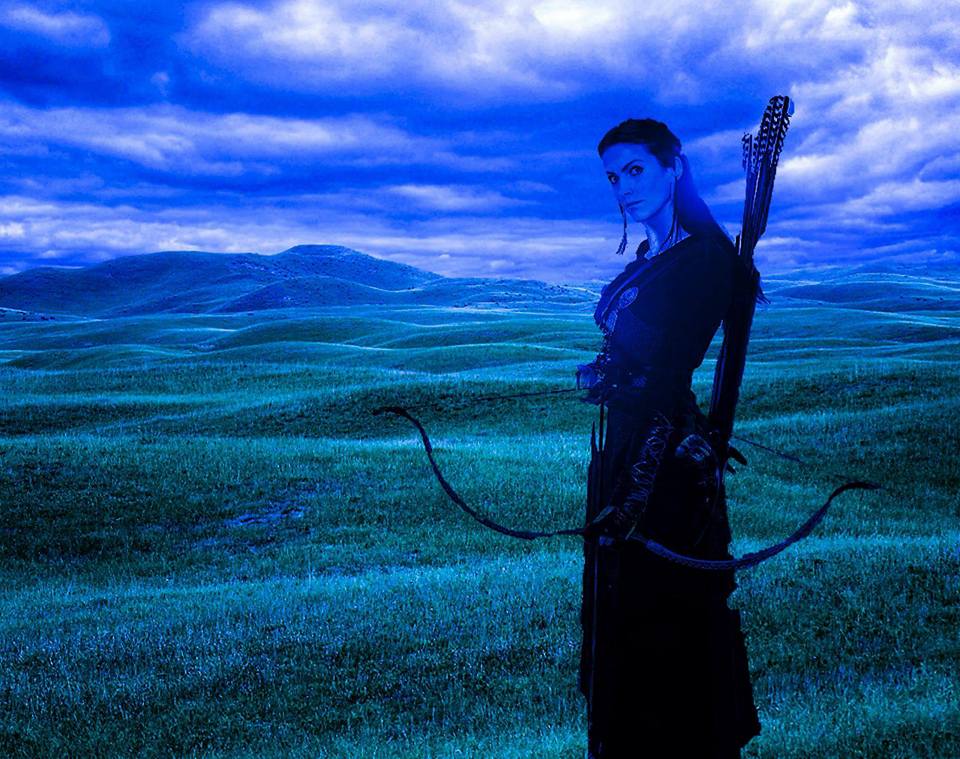
20.
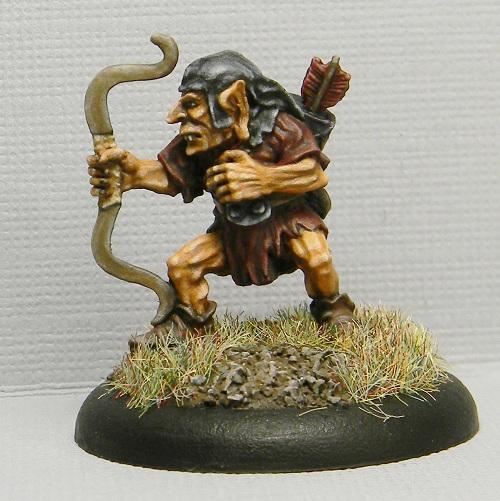
19.
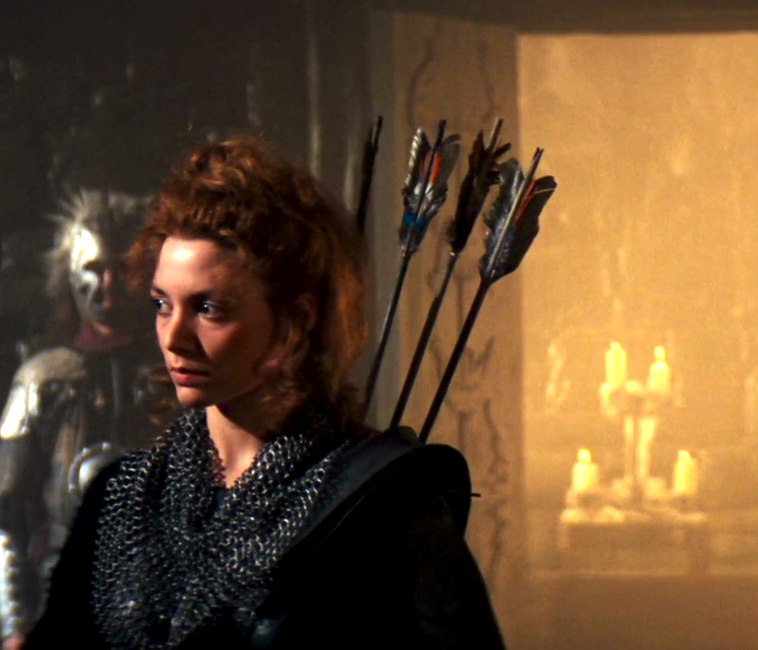
18.
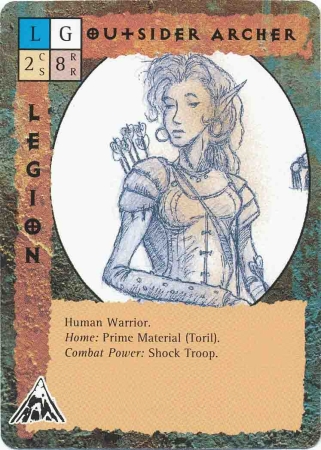
17.
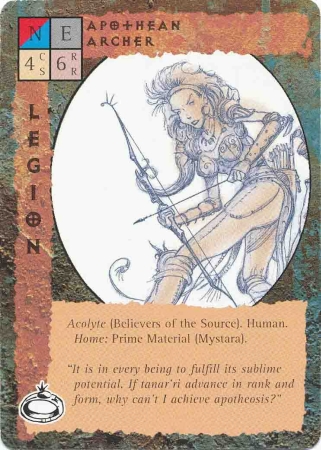
16.

15.
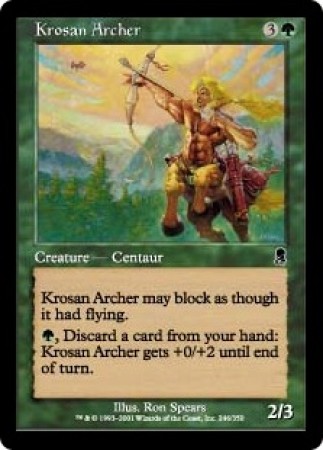
14.
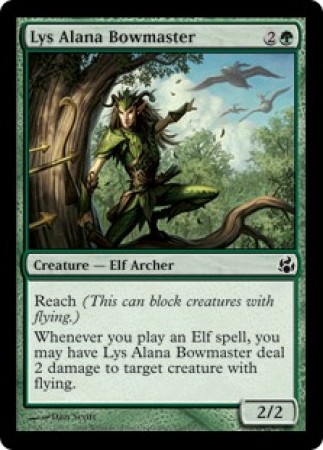
12.
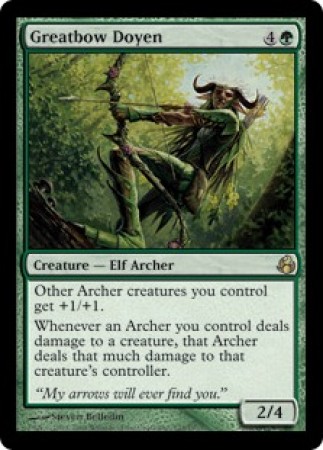
11.
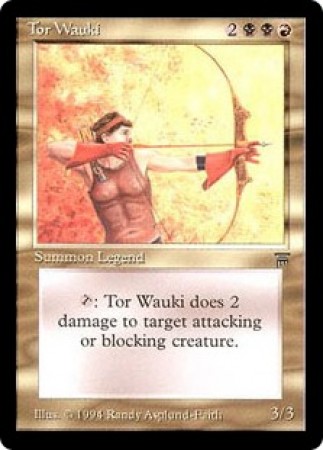
10.
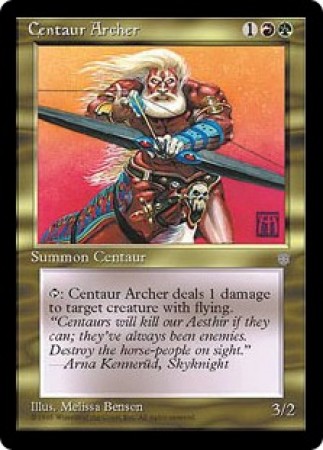
9.
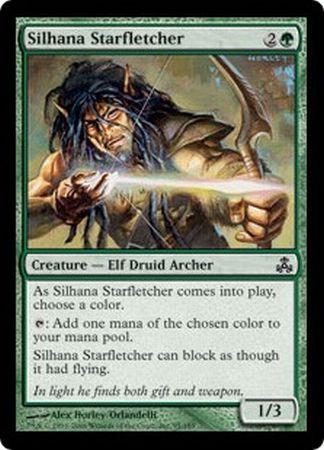
8.
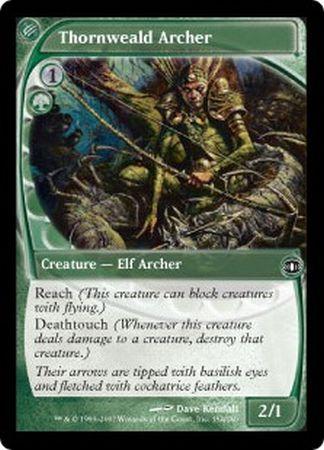
7.
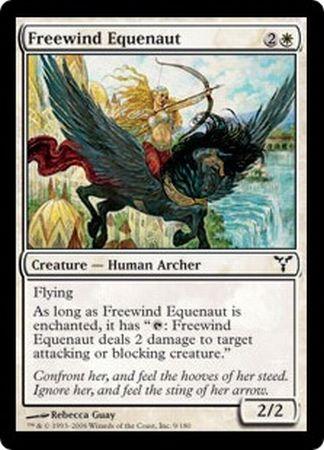
6.
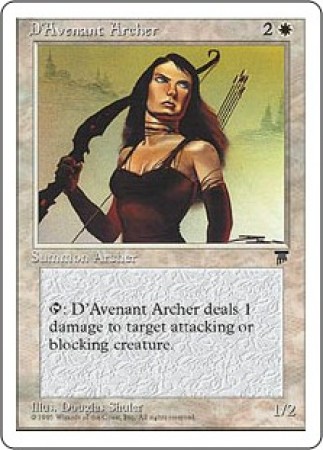
5.
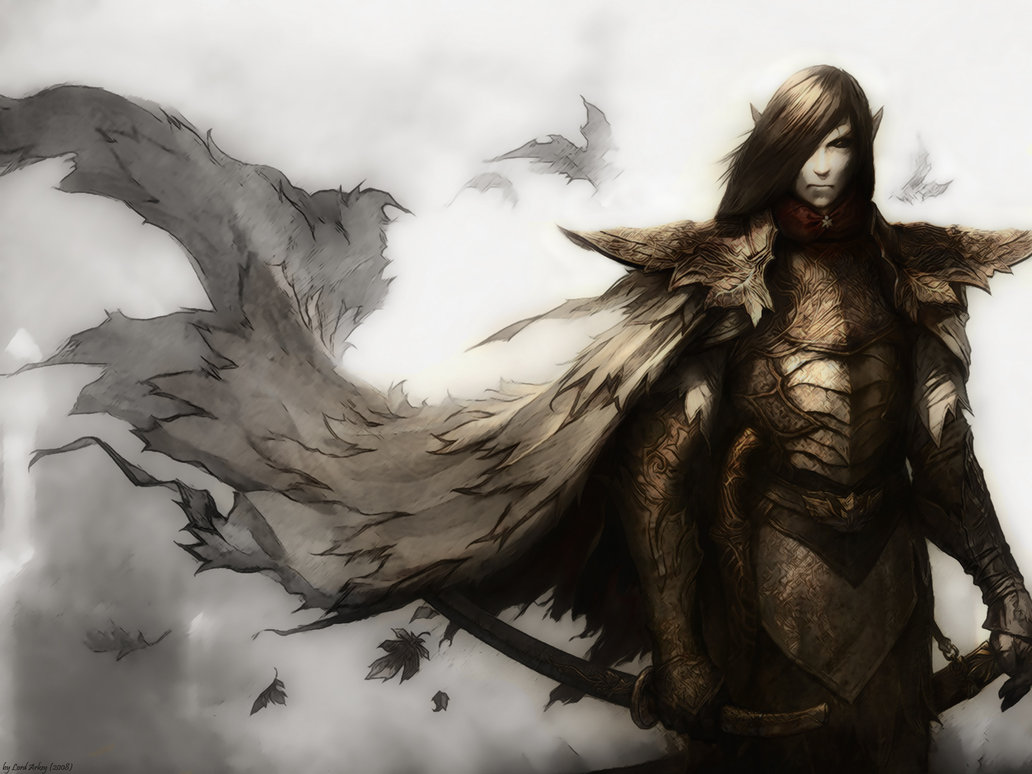
4.

3.
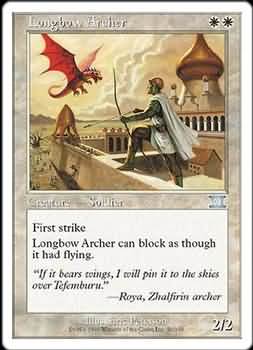
2.
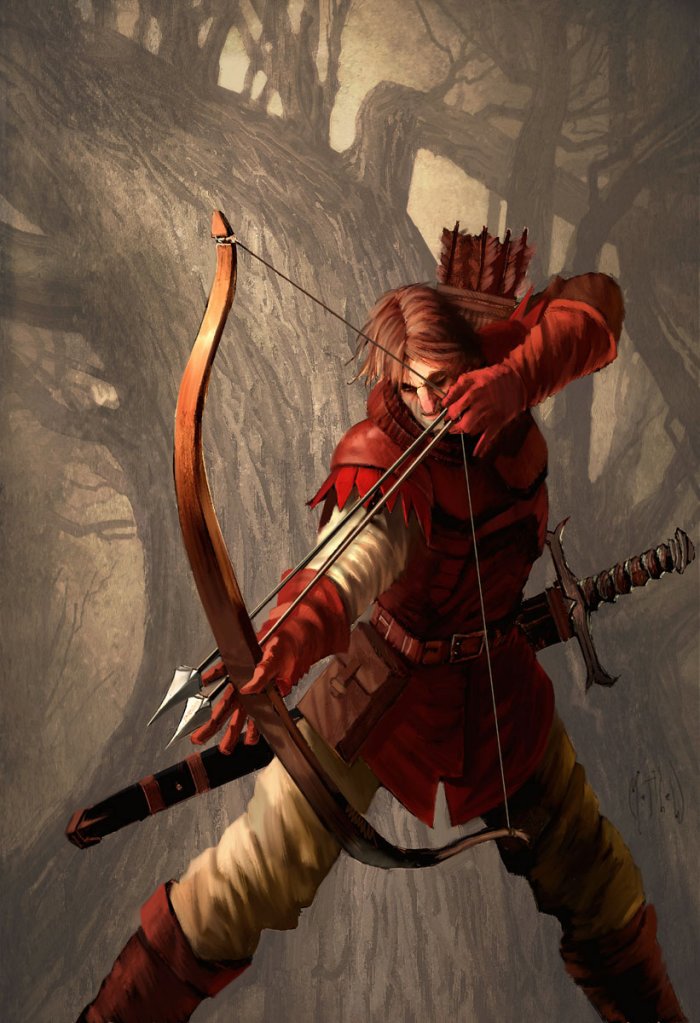
1.
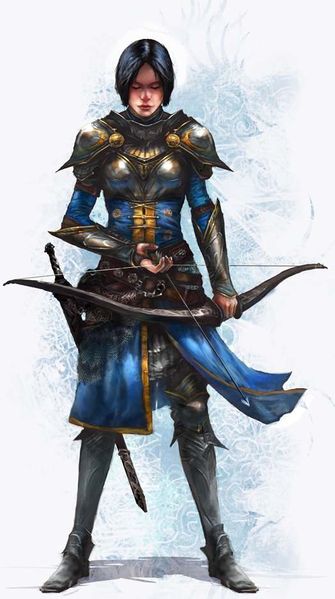
Those who are familiar with the Errol Flynn
movie Robin Hood may
recall a scene when he kills four or five
men-at-arms
with single arrow shots, all within one
minute (I've timed some
of the missile-firing melee scenes). We
have all seen some movies
in which the bow (usu. the longbow) is
fantastically accurate
and deadly. This pre-conditioning, if
you will, confuses many a
new player of the D&D or AD&D
game. The novice might
give up if the leader of a group of orcs
shouts out to his troops,
"Stand and deliver!" because the player
has a fear of the bow. On
the other hand, the party might refrain
from missile fire for the
opposite reason: Most monsters met in
an encounter cannot be killed
by a single arrow. Are, or were, archers
really as good as
they are sometimes portrayed to be?
A special archer?
Dear Dragon,
Should the archer NPC class (Best of
DRAGON Vol. III) be allowed to have the ability
of weapon specialization as described in Unearthed
Arcana?
Adam Lidz
Bala Cynwyd, Pa.
(Dragon #105)
If you're using the unofficial archer NPC
designed by Len Lakofka, the original bonuses to
hit and damage given in that article should be
retained, not replaced by the combat bonuses
given in Arcana for specialization
with a bow.
Those original bonuses are part of what makes an
archer an archer; besides, from 4th level on,
they're better than the bonuses given to a bow
specialist. On top of that, the archer gets an extra
+1 when using any magical bow or arrow. If you
find these advantages too powerful, you can treat
the archer more like a regular bow specialist. But
if these advantages haven't caused any game balance
problems in your campaign, then there's
no reason to replace them with the lower bonuses.
I can't think of a logical reason why archers
should be denied the benefit of the other aspects
of weapon specialization. If a bow specialist "who
begins the round with arrow nocked, shaft
drawn, and target in sight is entitled to loose that
arrow prior to any initiative check," then an
archer should be able to do this, too. An archer
should be able to do increased damage at point-blank
range just as a bow specialist can, but don?t
add in the archer?s damage bonus before doubling
the amount. Determine ?raw double damage
? first; e.g., an arrow +1 does 2-7 points of
damage, so ?raw? double damage? would be 4-
14 (2d6 + 2). A <14th-level archer> also gets +7 on
damage and an extra +1 for using a magic
arrow, for a total of 12-22. That's enough damage,
isn't it? I'd make the archer live with his
generally lower number of attacks per round (he
never gets better than 3/1), as some compensation
for his greater ability to hit and damage.
You'll need to solve other problems to make the
two systems mesh smoothly; for instance, they
differ in the definition of point-blank and short
range. Maybe you?ll want to rule that an archer
who benefits from some of the aspects of weapon
specialization can never have proficiency with
anything but a bow. You can use the two systems
side-by-side, or you can mesh one into the other
without making the archer too powerful. — KM